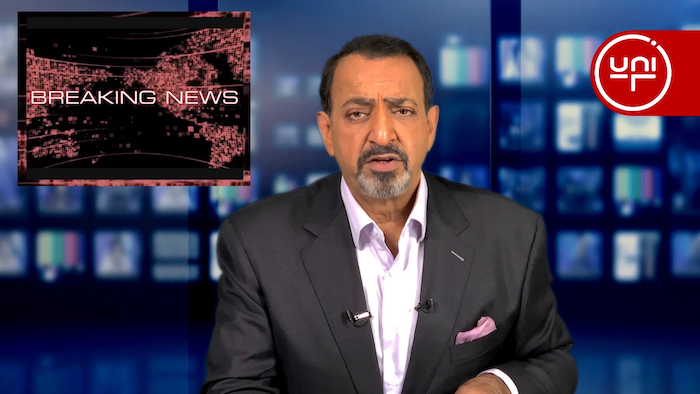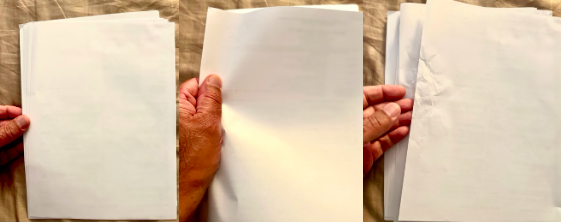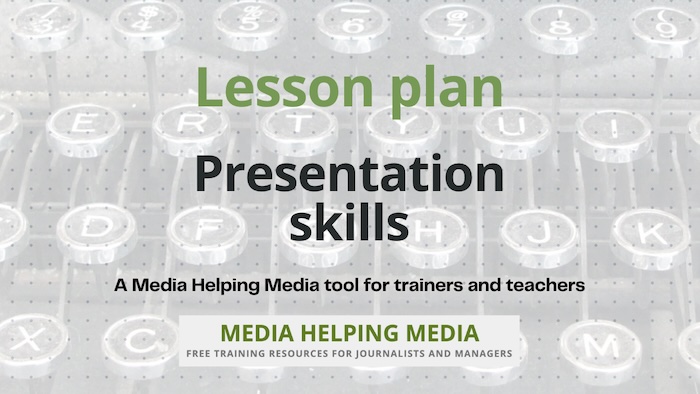
TV and radio presenters need to connect with the audience, building trust and respect. Here Riz Khan shares some tips for engaging viewers and listeners.
TV and radio presentation
The loss of presence when presenting for TV or radio is because you are being transmitted, on-screen in the case of television or online video, and through a speaker or headphones when listened to on radio or in an audio/podcast.
The way I describe it when training people how to broadcast, is to say that if, on a scale of 1 to 10, your personality is 7 (fairly engaging, expressive, and communicative), transmitted media will take you down to a 5, possibly even 4. You become a “flatter” version of yourself.
Let’s look at some practical tips to help overcome this when on-screen or on a microphone.
Body language
The most obvious problem with being on-screen is that your three-dimensional personality is now being transmitted in two dimensions. This is especially notable when presenting in a studio behind a desk, where you have limited options when it comes to movement.
Framing for video makes it unnatural for a person to be moving notably side-to-side or up and down – it would be very odd for a presenter to be bouncing up and down to any degree!
With those two dimensions restricted, you have to try to steal back some of the third dimension, the forward-backward axis. Again, it’s not natural for a presenter to lurch back and forth, however, subtly leaning forward or leaning back, and straightening up, can give the sense to the viewer that you are engaging them in a more personal manner.
In my case, when reading news bulletins or hosting talk shows, I combine subtle leaning forward and straightening up again with head tilting and positioning.
There is nothing wrong with looking down at the papers on the desk, even if you’re not specifically reading from them. In fact, it’s natural to look down and take a quick glance at notes.
This prevents the problem many presenters have of being transfixed to the autocue/teleprompter, staring like a deer in headlights, worried that looking away will cause the words on the prompter to disappear.
Try leaning forward a little while looking down at notes, then from the leaning forward position, just tilt your head up to look back into the camera for a couple of moments as you continue reading the bulletin. You can then gently straighten up your body as you continue to read.
These subtle moves in the third dimension – that forward-backward axis – will make it feel to the viewer that you are coming a little closer to them from time-to-time.
To take it to the next level, feel free to put subtle expression into your face. Use a slight raising of the eyebrows to emphasise something (this works especially well when leaning forward a little).
A face should never be rigid with no expression so feel free to add some facial movement.

The key is not to look like you are locked in a box, even though technically you are because you are limited to the two-dimensional parameters of a flat screen.
Also, don’t be afraid to move your notes across the desk. This helps to keep your scripts in line with what is on the teleprompter, and that is useful if, for some reason, the prompter fails.
Do, however, pay attention to moving the notes quietly and gently so the audio of papers being shuffled is not picked up on your microphone.
A trick I learned many years ago while working in radio was to “crumple” my script papers. This involved me grabbing each sheet of paper and squeezing it on the side of the hand with which I move the scripts in order to crunch it up a bit. This prevents the papers from feeling like they are stuck together. It’s a useful little trick.
I had watched a veteran radio news reader doing this before he went live, on-air and, later, when I asked why he had done this he said that it helps him gently lift the sheets of paper to put them to one side rather than struggling to get a grip on the edge of very flat papers lying on top of each other.
Initially I received funny comments from the studio director and others in the newsroom, however they did appreciate it when I was able to move papers silently.

Appearance
Some of this might sound obvious but it is surprising how many people are not aware of the need to pay attention to one’s appearance when on screen.
For example, bright or oversized jewellery can be distracting. This can include earrings, bracelets, broaches, etc., or even rings and watches in the case of men. These should be avoided so viewers don’t spend their time and attention on those rather than on you and what you’re saying.
In the case of outfits, loud, over-colourful or excessively flamboyant clothing can be distracting. Also patterns and designs, especially in the case of men’s suits, jackets or even shirts lines, strips, chequered designs or squares – and particularly herringbone – can play havoc with the camera, causing what is often called “moire” (pronounced “mwhar” or sometimes “mwah-ray”).
When using chroma key for creating a studio background there are further considerations.
Chroma key is often called “green screen” because that is the most commonly used colour as a backdrop, although, in theory, many colours work and weather presenters often perform in front of a blue screen.
When using chroma key it is, of course, important not to wear anything that matches the colour of the chroma key background (green, blue, etc.), otherwise it will cause a major problem to the integrity of your image.
Chroma key offers remarkable options but needs to be done properly to avoid the final result looking fake or inconsistent.

Make-up
This should look natural and not exaggerated whether for men or for women. Just something to note, it is always good to learn some basic make-up application yourself because it could be useful if needed at short notice, for example, while reporting on location, etc.. Even some basic, “studio fix” powder can work well to reduce the shiny areas most of us have under video/studio lighting. Learn your skin colour and find a powder to match. If you use the wrong colour it can look exaggerated and unappealing. Be proud of who you are and be the best you!
Voice
This applies to working in radio or recording a podcast as well as with on-screen work. Much of the “stolen character” is the result of how your voice comes across when broadcasting.
For many people, as soon as a microphone or camera is involved, there is a tendency to become “flatter” in terms of expressiveness. Sometimes this is because of the effort of focussing on the content, and sometimes it’s simply because of nervousness. It can even just be the result of being naturally soft or low-key when speaking normally.
The outcome is that your voice will have relatively less volume and expressiveness in terms of inflection, emphasis, and variation in tone.
During training sessions, I usually start by telling people to raise the volume of their voice, as if they are talking to someone who is farther away. The reaction I usually get is that they are worried they will sound like they are shouting. However, when I record the before and after, they are usually surprised at how they come across with more presence.
The next step is then to get them to start emphasising certain words. This can be done not only by putting more stress on the word, as we all tend to do when emphasising something, but also to add a very short pause before the word, or adding an inflection.
It might feel strange to you at first, almost like you are faking the way you are speaking, but with practice, it can come across not only as natural but with more character and authority.
I compare this to actors having to project when on stage in the theatre and those being recorded with microphones when filming movies. Theatre work requires more projection – a “larger” version of one’s self in order to connect with the audience.
One thing to try to be aware of is how audible your breaths are as you speak. There are many broadcasters who suck in air between sentences in a very noticeable way and, unfortunately, once you notice it, it becomes harder not to be a bit distracted by it.
Try not to be in a rush. I have always had the bad habit of speaking very quickly. This is not a good thing, especially when broadcasting internationally to an audience where many people would have English as a second language. It has taken me time and conscious effort to slow myself down – and even then, I could do more.
Take your time and focus on delivering the content in a measured way at a good pace. The BBC used to have a rough guide of three words per second, but I think things have sped up a bit since then. Still, it’s in your interest to make sure that people get to hear everything you have to say, so, as well as the tone, emphasis, inflection (and, hopefully well-written content), you need to control the pace of delivery.
Don’t be afraid to pause. A second is only a second, even though it might feel like a lifetime when live on air. Good pacing will also reduce the chance of mistakes.
Remain relaxed, remember to breathe evenly, and not so audibly that it’s distracting! As much as possible try to enjoy the job of broadcasting.
Yes, it does involve a certain amount of “acting”, but, done well, it can significantly improve your presence and authority as a broadcaster.
Radio
I have already covered how to improve the use of your voice in the section above, but there are a couple of extra considerations that apply to radio in particular.
Microphones for on-screen broadcasting are usually discreet, fitted to the lapel of a man or woman’s jacket or hidden as much as possible on any other outfit so that the cable is not dangling and distracting.
These lapel mics, often called lavaliers, are in a fixed position on one’s body. As a result they are fairly consistent in how they record your voice. You should also be aware that their position on your body will affect the tone and depth of your voice, as well as how prone they might be to picking up background noise.
In the case of audio-only recording, you have much more flexibility in how you control the “feel” of your voice. This is one of the reasons I’m such a big fan of radio. It’s possible to change the mood of one’s voice simply by positioning the proximity of one’s mouth with the microphone. It takes practice but can add a great feel to the audio content, such as a warmer tone with more bass notes when speaking up close to the mic.
Any time you are reading from script papers on radio, where teleprompters generally don’t exist, the “crumpling” of the papers and notes is even more useful in avoiding extraneous and distracting noise, so use that trick to separate the sheets for more easy handling.
Writing content for audio as opposed to video is a whole learning session in itself, but needless to say, the mood, feel, and expression in your voice is all the more important in radio or on a podcast, where there are no pictures to guide the story.
Conclusion
There is quite a lot to consider when maximising your potential as a broadcaster in order to best engage with your audience.
Many of the tips I have shared may seem obvious but are often overlooked. The main point is to be as natural as you can so that you can come across as the best version of you as a broadcaster, you don’t have to mimic anyone else.
Being relaxed, feeling in control, and actually trying to enjoy the job of being a broadcaster is central to coming across as a good, engaging communicator.
It may be somewhat subconscious but viewers and listeners can actually “feel” the mood of those to whom they listen and watch so try to put the most positive energy you can into your work.
Good luck!
Below are some interviewing techniques that might help presenters who conduct live interviews.
By RizKhan

Questions
- What is the main challenge that Riz Khan identifies when presenting on TV or radio?
- How does Riz Khan suggest overcoming the two-dimensional limitation of on-screen presentation?
- Describe one technique mentioned by Riz Khan to prevent appearing “flat” when broadcasting.
- Why does Riz Khan advise against wearing bright or oversized jewellery on screen?
- Explain the concept of “chroma key” and its importance in broadcasting.
- What is the purpose of “crumpling” script papers according to Riz Khan?
- How does Riz Khan recommend improving voice expressiveness during broadcasting?
- Discuss the role of body language in enhancing a broadcaster’s presence according to the text.
- What are some considerations for using microphones in radio versus on-screen broadcasting?
- How does Riz Khan suggest broadcasters can maintain a natural and engaging presence?
Answers
- The main challenge is that part of who you are is diminished, making you come across as flat and lifeless.
- Riz Khan suggests using subtle movements like leaning forward or back and head tilting to engage the viewer more personally.
- One technique is to subtly lean forward while looking down at notes, then tilt the head up to look into the camera.
- Bright or oversized jewellery can distract viewers from focusing on the presenter and the content being delivered.
- Chroma key, often called “green screen,” allows for various backgrounds but requires avoiding clothing that matches the background colour.
- “Crumpling” script papers makes them easier to lift and separate without noise, preventing distraction during broadcasting.
- He recommends raising the volume and emphasising certain words with stress, pauses, or inflection to add character and authority.
- Body language, such as subtle movements and facial expressions, helps convey a three-dimensional personality on a two-dimensional screen.
- On-screen microphones are usually fixed and discreet, while radio allows more flexibility in voice tone and mood through mic positioning.
- Broadcasters should be relaxed, feel in control, and enjoy the job to come across as natural and engaging
Lesson plan for trainers
If you are a trainer of journalists we have a free lesson plan: ‘Engaging viewers and listeners’ which you are welcome to download and adapt for your own purposes.









